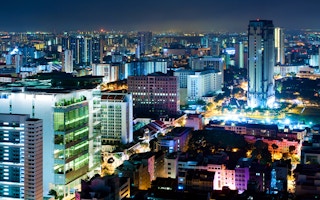Emerging lighting technologies are the next frontier in helping cities reduce their energy consumption and create more enjoyable landscapes for their residents, said Mieke De Schepper, general manager of Philips Lighting Singapore at a media sharing session entitled “How our lives in Asian cities will be impacted by lighting innovations” on Tuesday, in conjunction with the i Light Marina Bay 2014 festival.
To continue reading, subscribe to Eco‑Business.
There's something for everyone. We offer a range of subscription plans.
- Access our stories and receive our Insights Weekly newsletter with the free EB Member plan.
- Unlock unlimited access to our content and archive with EB Circle.
- Publish your content with EB Premium.
De Schepper, along with professors Thomas Schroepfer and Suranga Nanayakkara from the Singapore University of Technology and Design (SUTD), shared how lighting is a “low-hanging fruit” in terms of the energy that can be saved in buildings and urban infrastructure.
Philips, which has two exhibits at the festival, used hardware such as innovative LED lamps, and software solutions such as sensor-controlled, programmable lighting systems for these art installations. The lights of the interactive iSwarm exhibit, for example, are controlled by 34 sensors located along the surrounding railings, and these change colours depending on audience movements.
Philips offers these technologies as simultaneously sustainable and attractive. “We are committed to offering lighting solutions which improve people’s lives that are innovative and environmentally sound”, said De Schepper.
“Innovations in LED lighting have opened a new frontier of possibilities in green design and ultimately how our cities look and feel. i Light Marina Bay provides an opportunity to bring these possibilities into the conversation,” added associate professor Schroepfer.
In commercial buildings, a study by the US-based New Buildings Institute shows that lighting accounts for 20 per cent of the total energy usage, and 38 per cent of electricity consumption. According to the Association of the German Electrical Industry, this energy consumption can be reduced by up to 80 per cent using intelligent lighting systems, indicating the potential for improved energy efficiency and cost savings by examining lighting use in buildings.
At the event, De Schepper and associate professor Schroepfer also explained how the interactive technologies seen at the Philips’ i Light Marina Bay 2014 exhibits could be applied to commercial buildings. Doing so could result in lights being automatically dimmed in spaces with less traffic or activity; lighting brightness could be adjusted according to ambient light, and individuals would be able to optimise the hue and brightness of their workspaces for maximum productivity, said the two. By introducing real-time, smart sensing of occupants’ lighting needs of occupants, and changing multiple variables, these new lighting technologies help optimise energy usage and user experience, they added.
“
This rise of cities has created competitive desires to establish a strong city identity with a higher quality of life and conditions for strong economic growth. An intelligent, connected public lighting infrastructure can enhance the liveability of cities.
Mieke de Schepper, general manager, Philips Lighting Singapore
These technologies are also as economical as they are energy efficient. Professor Nanayakkara shared that each of the 1,200 lights used in the iSwarm installation consumes only 1W of power. The energy required to run these 1,200 lights for three and a half hours every evening only cost S$1.07 a day, he said. A cost analysis study by Philips also shows that where road lighting is concerned, installing LED systems have payback periods of as little as 2 to 3 years, depending on local energy costs.
The potential of these cost-effective lighting solutions to make cities more sustainable and liveable is gaining more traction in Singapore. In the latest version of the Building and Construction Authority’s (BCA) Green Mark certification for new buildings, there is a new criteria on incorporating daylighting into buildings. The addition of a new lighting-based criteria increases the overall weightage that lighting efficiency contributes to a building’s score, and makes it a more salient concern for developers and building managers.
Innovative hardware and software lighting solutions could also help other cities in Asia meet increasing energy demand in a reliable and cost effective way. The Asian Development Bank predicts that due to the addition of 44 million people every year in Asia’s cities, the region will account for one-third of global energy consumption by 2025. Related to this, Asia is also predicted to contribute 56 per cent of the growth in global carbon dioxide emissions over the 1990 to 2025 period. The rapidly growing cities are also likely to face qualitative concerns of improving indicators such as safety, and quality of life for their growing populations. Lighting technologies could help reduce the burden faced by cities as they work to manage this rapid growth, said Philips.
“This rise of cities has created competitive desires to establish a strong city identity with a higher quality of life and conditions for strong economic growth. An intelligent, connected public lighting infrastructure can enhance the liveability of cities by creating a resource-efficient city, contributing to the safety and security of all citizens, and establishing an attractive, vibrant image”, said De Schepper.










